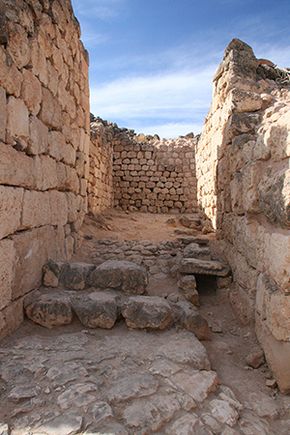
Sumhuram, the entrance to the city (IMTO archive)
Sumhuram, the port of frankincense
The ancient port of Sumhuram was situated in the territory of Khor Rori. The importance of this city was linked to its geographical position overlooking a splendid natural port located close to the Nejd, the area on the edge of the desert where the most prized variety of frankincense was produced. From here baskets filled with the precious resin, freshly harvested from the
Boswellia sacra tree, were carried on camel-back to warehouses in the city. From Sumhuram they were then transported across the sea to markets in India and the Mediterranean. The unique beauty of the site, poised between the desert and the sea, and the magical atmosphere that reigns there has always enchanted travellers to Sumhuram. Antique sources tell us that the port and its precious goods were protected by a deity, and even today the inhabitants of the region of Khor Rori believe that their land is guarded by beneficent spirits.
The city of Sumhuram
The city of Sumhuram was founded in the 3
rd century BC and was abandoned in the 5
th century AD. It was an important stopping point for merchant ships travelling the immense distances between the Mediterranean and India, and the large numbers of imported objects that have been excavated testify to the flourishing trade that was conducted between this city and various parts of the world. Sumhuram was surrounded by an imposing defensive wall complete with watch towers and a monumental city gate. Notwithstanding its modest size (covering no more than a hectare), the town was laid out along the lines of a metropolis complete with a residential quarter, a large area of warehouses for the storage of goods, a splendid temple, and a small sanctuary where the gods could be venerated. A well 25 meters deep, a network of canals, and numerous water basins guaranteed a supply of fresh water for the inhabitants. Evidence of bustling economic activity has been discovered, including metal ware production and food preparation. It also appears that the city minted its own coins.
The surrounding territory
The city of Sumhuram stands today in splendid isolation, in a region which for the greater part of the year is extremely arid, with vegetation limited to a few sparse shrubs. Nevertheless, in the distant past the environment appears to have been completely different. Analysis of pollen samples and the remains of terraced fields and weirs demonstrate that agriculture was widely practiced, and excavations have brought to light evidence of long and uninterrupted human settlement. Certain finds, such as a temple situated along the edge of the coastal lagoon, caves used for burials, and structures in an area lying to the north of the city, are contemporary with the urban settlement. It is clear that the area was inhabited in even earlier times, as signs of human activity dating from the Bronze Age have been discovered on the promontory along the eastern side of the natural port. A small mosque on the edge of the lagoon and buildings on the eastern promontory have also been found that date from the Medieval Period.
Click here for a virtual visit of the site
